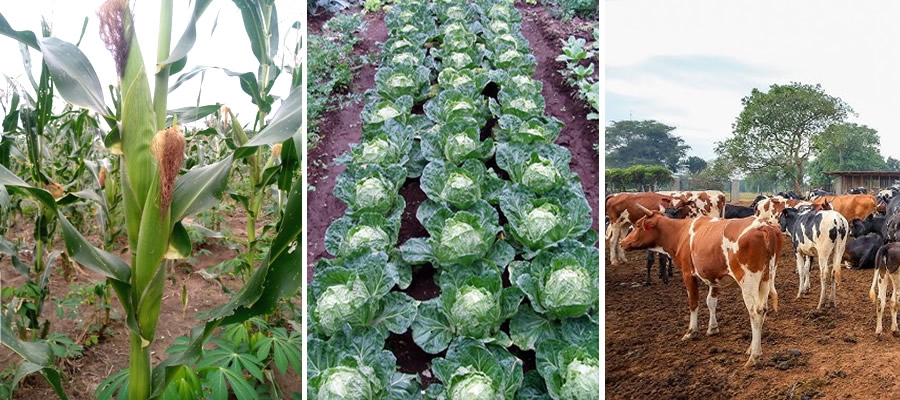

Agricultural Sector
Crop Production
Major agricultural commodities produced in the municipality are maize, cassava, vegetables (pepper, okra and cabbage), macro and micro livestock (macro - sheep, goat, Pigs and cattle and micro – grass cutter and rabbit) and poultry products. Table 1.8 below provide a snapshot of the average production levels of the major crops produced in the Municipality with Table 1.9 doing same for livestock/Poultry production. As shown in Figure 12 production levels for all the crops continue to grow despites the fact that agriculture production in the Municipality have experience some major challenges in recent decades, prominent among them being the loss of existing farmlands to sand winners and real estate development and the acquisition of land for private housing projects.
The situation is especially promising for Cabbage production with most farmers taking advantage of the many water bodies that exist in the Municipality. Most of these farmers farm along the banks of the Nsakyi River which serves as source of water for irrigating crops, whiles some staff of Ministry of Agriculture and CSIR farm on the Research lands. The average farm size is estimated at 0.5 acre.
Other programmes that have been promoted by the Municipal Agricultural Directorate to boost yield have included: Promotion of Backyard Farming, Implementation of the Planting for Food and Jobs Programme, Implementation of the Rearing for Food and Jobs Programme, Deployment of More Agric Extension Officers.
The total population of farmers is estimated at two thousand and fifty (2,050) comprising of one thousand three hundred and ninety (1,390) (67.9%) males and six hundred and sixty females (660) (32.1%) with an estimated average farmer age at forty-five (45) years. The current estimated number of farm households stands at one thousand five hundred (1,500) with an average household size of four (4.0).
Average Production Levels for Livestock and Poultry
Livestock production in the Municipality is mainly into the rearing of Macrosheep, goat, Pigs, cattle, Micro-grasscutter, rabbit and poultry products. Table 1.9 provides the production levels in Animal production over the past years. As shown in Figure 13, production is mostly done in the homes of farmers due to inadequate farm lands and constant stealing of farm animals in the municipality, population in micro livestock especially broilers have been increasing rapidly to contribute to Agricultural production.
Post-Harvest Losses
Significant post-harvest losses particularly cassava, maize and vegetables are recorded in the Municipality. The annual post-harvest losses estimate for maize is at 20 to 25%. The losses are even higher in fruits, vegetables and cassava.
Apart from few traditional silos, warehouses with drying facilities are virtually absent. There are no storage facilities for perishable crops in the Municipality, however there are ssome processors who process pineapples into juice, and some local processors who process cassava into gari and cassava doe. Most of the roads leading to the farming areas are not motorable, hence harvested produce cannot be transported leading to post harvest loses, also cost of transportation increases.
Date Created : 2/25/2025 12:00:00 AM











 facebook
facebook
 twitter
twitter
 Youtube
Youtube
 +233 593 831 280
+233 593 831 280 0800 430 430
0800 430 430 GPS: GE-231-4383
GPS: GE-231-4383 info@ghanadistricts.com
info@ghanadistricts.com Box GP1044, Accra, Ghana
Box GP1044, Accra, Ghana